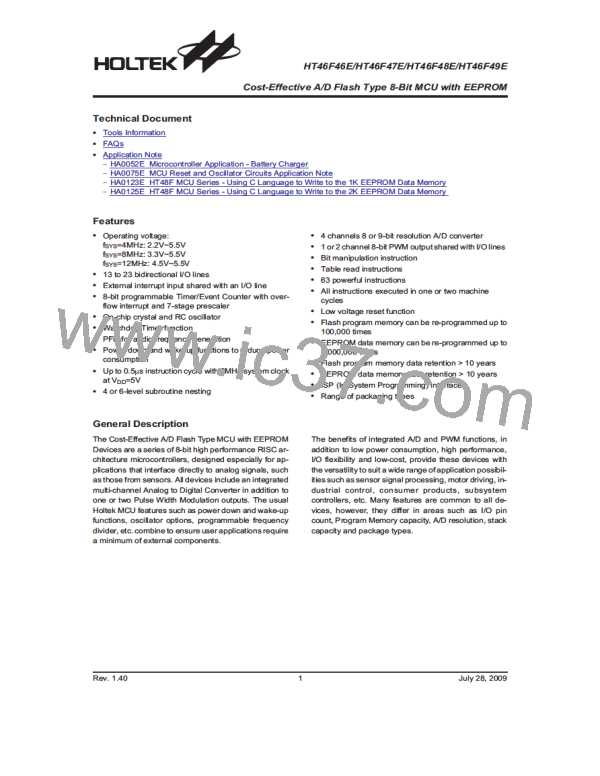HT46F46E/HT46F47E/HT46F48E/HT46F49E
Watchdog Timer Oscillator
also be taken into account by the circuit designer if the
power consumption is to be minimized. Special atten-
The WDT oscillator is a fully integrated free running RC
oscillator with a typical period of 65ms at 5V, requiring no
external components. It is selected via configuration op-
tion. If selected, when the device enters the Power Down
Mode, the system clock will stop running, however the
WDT oscillator will continue to run and keep the watch-
dog function active. However, as the WDT will consume a
certain amount of power when in the Power Down Mode,
for low power applications, it may be desirable to disable
the WDT oscillator by configuration option.
tion must be made to the I/O pins on the device. All
high-impedance input pins must be connected to either
a fixed high or low level as any floating input pins could
create internal oscillations and result in increased cur-
rent consumption. This also applies to devices which
have different package types, as there may be
undonbed pins, which must either be setup as outputs
or if setup as inputs must have pull-high resistors
connected. Care must also be taken with the loads,
which are connected to I/O pins, which are setup as out-
puts. These should be placed in a condition in which
minimum current is drawn or connected only to external
circuits that do not draw current, such as other CMOS
inputs. Also note that additional standby current will also
be required if the configuration options have enabled the
Watchdog Timer internal oscillator.
Power Down Mode and Wake-up
Power Down Mode
All of the Holtek microcontrollers have the ability to enter
a Power Down Mode, also known as the HALT Mode or
Sleep Mode. When the device enters this mode, the nor-
mal operating current, will be reduced to an extremely
low standby current level. This occurs because when
the device enters the Power Down Mode, the system
oscillator is stopped which reduces the power consump-
tion to extremely low levels, however, as the device
maintains its present internal condition, it can be woken
up at a later stage and continue running, without requir-
ing a full reset. This feature is extremely important in ap-
plication areas where the MCU must have its power
supply constantly maintained to keep the device in a
known condition but where the power supply capacity is
limited such as in battery applications.
Wake-up
After the system enters the Power Down Mode, it can be
woken up from one of various sources listed as follows:
·
An external reset
·
An external falling edge on Port A
·
A system interrupt
·
A WDT overflow
If the system is woken up by an external reset, the de-
vice will experience a full system reset, however, if the
device is woken up by a WDT overflow, a Watchdog
Timer reset will be initiated. Although both of these
wake-up methods will initiate a reset operation, the ac-
tual source of the wake-up can be determined by exam-
ining the TO and PDF flags. The PDF flag is cleared by a
system power-up or executing the clear Watchdog
Timer instructions and is set when executing the ²HALT²
instruction. The TO flag is set if a WDT time-out occurs,
and causes a wake-up that only resets the Program
Counter and Stack Pointer, the other flags remain in
their original status.
Entering the Power Down Mode
There is only one way for the device to enter the Power
Down Mode and that is to execute the ²HALT² instruc-
tion in the application program. When this instruction is
executed, the following will occur:
·
The system oscillator will stop running and the appli-
cation program will stop at the ²HALT² instruction.
·
The Data Memory contents and registers will maintain
their present condition.
Each pin on Port A can be setup via an individual config-
uration option to permit a negative transition on the pin
·
The WDT will be cleared and resume counting if the
WDT clock source is selected to come from the WDT
oscillator. The WDT will stop if its clock source origi-
nates from the system clock.
to wake-up the system. When a Port A pin wake-up oc-
curs, the program will resume execution at the instruc-
tion following the ²HALT² instruction.
·
The I/O ports will maintain their present condition.
·
In the status register, the Power Down flag, PDF, will
If the system is woken up by an interrupt, then two possi-
ble situations may occur. The first is where the related
interrupt is disabled or the interrupt is enabled but the
stack is full, in which case the program will resume exe-
cution at the instruction following the ²HALT² instruction.
In this situation, the interrupt which woke-up the device
will not be immediately serviced, but will rather be ser-
viced later when the related interrupt is finally enabled or
when a stack level becomes free. The other situation is
be set and the Watchdog time-out flag, TO, will be
cleared.
Standby Current Considerations
As the main reason for entering the Power Down Mode
is to keep the current consumption of the MCU to as low
a value as possible, perhaps only in the order of several
micro-amps, there are other considerations which must
Rev. 1.40
54
July 28, 2009

 HOLTEK [ HOLTEK SEMICONDUCTOR INC ]
HOLTEK [ HOLTEK SEMICONDUCTOR INC ]